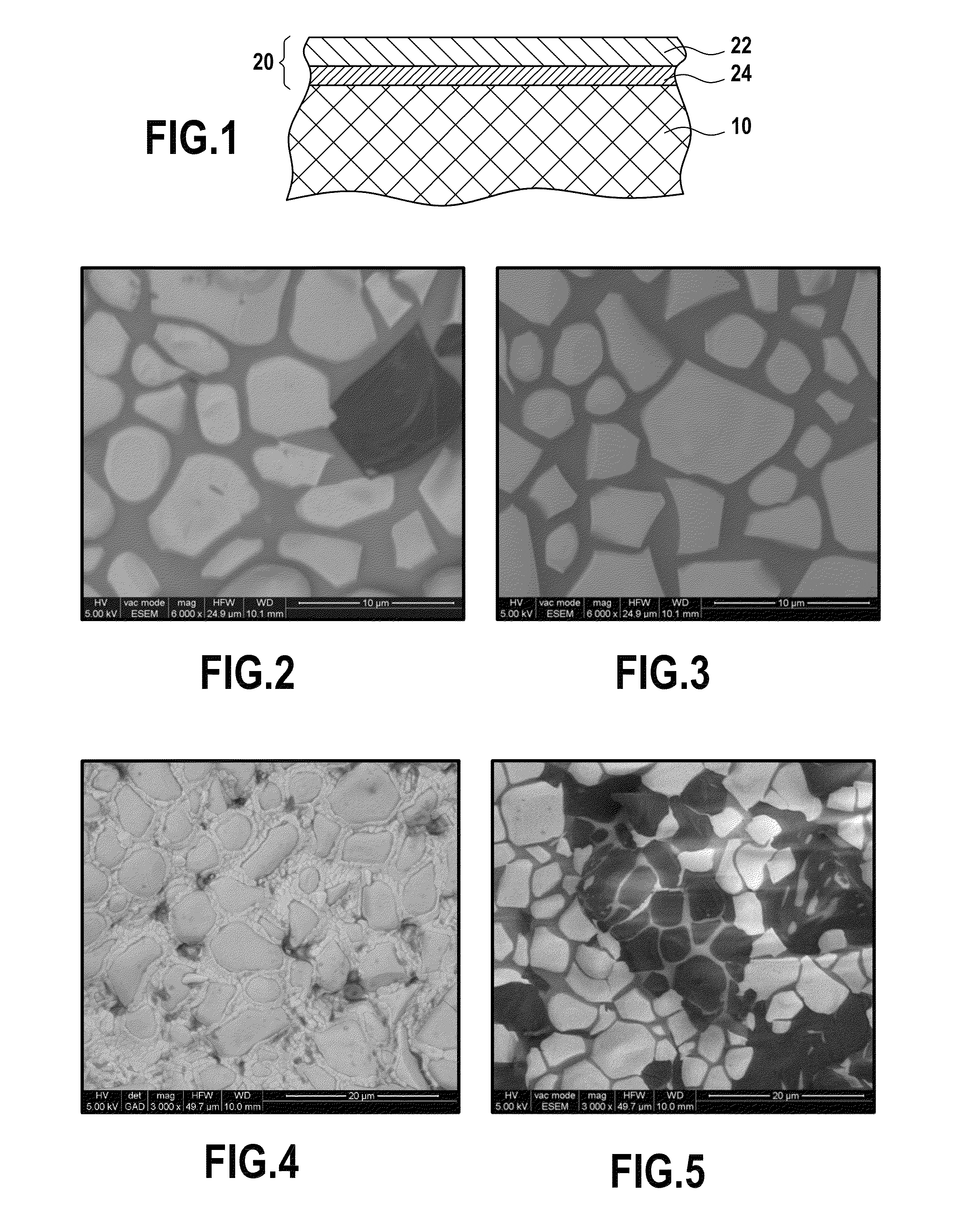Environmental barrier for a refractory substrate containing silicon
a technology of environment barrier and refractory substrate, which is applied in the direction of wind motor components, non-positive displacement fluid engines, liquid fuel engine components, etc., can solve the problems of significant degradation, difficult to envisage above use, and oxidation into silica, so as to achieve the effect of conserving its effectiveness
- Summary
- Abstract
- Description
- Claims
- Application Information
AI Technical Summary
Benefits of technology
Problems solved by technology
Method used
Image
Examples
example 1
[0050]An SiC / SiC composite material substrate comprising fiber reinforcement made of SiC fibers and an SiC matrix, was provided with an environmental barrier as follows:[0051]depositing an underlayer of yttrium silicate Y2Si2O7 from an Y2Si2O7 powder onto the SiC / SiC substrate by plasma spraying, the underlayer having a thickness of about 200 μm; and[0052]depositing an outer layer on the underlayer by plasma spraying, starting from a mixture of powders of mullite (15 mol %) and of Y2Si2O7 (85 mol %) giving a composition that formed a system of Y2O3 (53.61 weight percent (wt %)), SiO2 (33.57 wt %), and Al2O3 (12.82 wt %), with the thickness of the outer layer being about 100 μm.
[0053]At 1400° C. and at 1450° C. the outer layer possessed a liquid phase capable of sealing cracks that appear in the environmental barrier, and having two solid phases at 1400° C. and one solid phase at 1450° C.
[0054]FIG. 2 shows a portion of the surface of the outer layer after its temperature had been rai...
example 2
[0056]The procedure was as in Example 1, but the outer layer was formed from a mixture of powders of mullite (41.2 mol %) and of Y2Si2O7 (58.8 mol %), giving a composition forming the following system: Y2O3 (35.04 wt %), SiO2 (31.71 wt %), and Al2O3 (33.25 wt %).
[0057]FIG. 5 shows a portion of the surface of the outer layer after 50 h under air at 1400° C. The liquid phase identical to that of Example 1 occupies all of the space between the grains of Y2Si2O7 (white) and of mullite and of Al2O3 (black), thereby providing self-healing. In the composition of the outer layer, the liquid phase represented about 5 mol % to 8 mol %.
[0058]It should be observed that at 1450° C., the outer layer melted, with the quantity of liquid phase becoming excessive.
example 3
[0059]The procedure was as in Example 1, but the outer layer was formed from a mixture of powders of mullite (54.4 mol %) and of Y2Si2O7 (45.6 mol %), giving a composition forming the following system: Y2O3 (26.43 wt %), SiO2 (30.85 wt %), and Al2O3 (42.72 wt %).
[0060]FIG. 6 shows a portion of the surface of the outer layer after 50 h in air at 1400° C. A liquid phase identical to that of Example 1 was indeed formed, but the quantity of liquid phase was insufficient, so that pores remained. Self-healing therefore could not be achieved completely. In the composition of the outer layer, the liquid phase represented significantly less than 5 mol %.
[0061]At 1450° C., the outer layer had melted, with the quantity of liquid becoming excessive.
PUM
| Property | Measurement | Unit |
|---|---|---|
| temperature | aaaaa | aaaaa |
| temperature | aaaaa | aaaaa |
| temperature | aaaaa | aaaaa |
Abstract
Description
Claims
Application Information
 Login to View More
Login to View More - R&D
- Intellectual Property
- Life Sciences
- Materials
- Tech Scout
- Unparalleled Data Quality
- Higher Quality Content
- 60% Fewer Hallucinations
Browse by: Latest US Patents, China's latest patents, Technical Efficacy Thesaurus, Application Domain, Technology Topic, Popular Technical Reports.
© 2025 PatSnap. All rights reserved.Legal|Privacy policy|Modern Slavery Act Transparency Statement|Sitemap|About US| Contact US: help@patsnap.com



